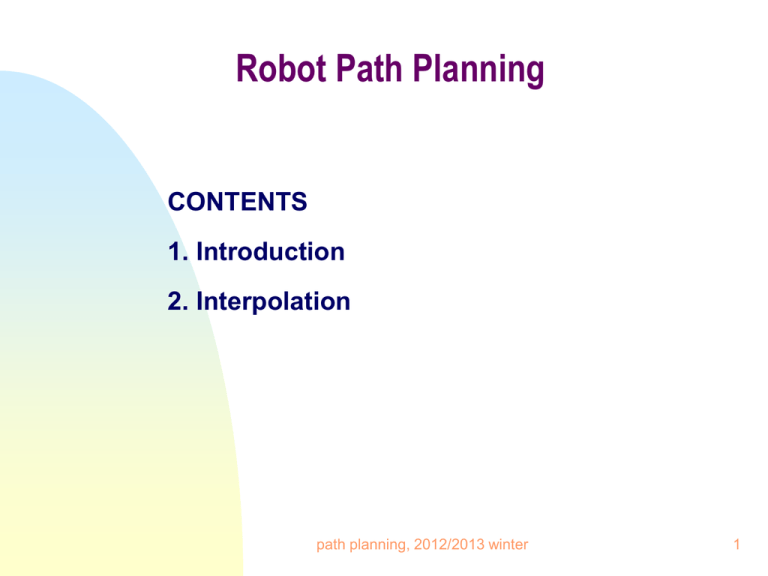Robot Path Planning
advertisement

Robot Path Planning CONTENTS 1. Introduction 2. Interpolation path planning, 2012/2013 winter 1 Robot Path Planning Introduction The user specifies goal points at the end effector level. There is an issue about the intermediate points so that the motors can run continuously. The intermediate points are points between the starting point and the end point. A robot has two degrees of freedom (i.e., two motors at joints) motor position Robot Path Planning Goal points are converted to joint points -> joint scheme, so the issue becomes to determine the intermediate angles given two angles as well as their time stamps (see Figure 1). θ1 A robot has two degrees of freedom (i.e., two motors at joints) Motor 1 t θ2 motor position path planning, 2012/2013 winter t Motor 2 3 Robot Path Planning Criterion of determining these intermediate angles is: “smoothness” of the motion. Joint space schemes The problem of planning at the end effector is converted to the problem of path planning at the joint level path planning, 2012/2013 winter 4 Robot Path Planning Interpolation: Given the initial and end goal points, there are different ways to interpolate, see Figure 2. Figure 2 Rotary motor path planning, 2012/2013 winter 5 Robot Path Planning Cubic polynomials: There are at least four conditions to constrain the interpolation: ( 0) 0 (t f ) f (1) (2) . ( 0) 0 (3) . (t f ) 0 path planning, 2012/2013 winter (4) 6 Robot Path Planning These four constraints can be satisfied by a polynomial of at least third degree. A cubic has the form: (t ) a0 a1t a2t a3t 2 3 (5) We can get the velocity and acceleration expression for the above equation (5). We can determine the coefficients as follows: path planning, 2012/2013 winter 7 Robot Path Planning a0 0 a1 0 a2 3 2. .t f ( f 0 ) 2 a3 3 ( f 0 ) tf path planning, 2012/2013 winter (6) 8 Robot Path Planning Example: A single-link robot with a rotary joint is motionless at 15 It is desired to move the joint in a smooth manner to 75 in 3 seconds. Find the coefficients of a cubic which path planning, 2012/2013 winter 9 Robot Path Planning accomplishes this motion and brings the manipulator to rest at the goal. Solution can be found by plugging into the equations for the coefficients, we can find: path planning, 2012/2013 winter 10 Robot Path Planning a0 15.0 Figure 3 shows the position a1 0.0 Velocity a 2 20.0 Acceleration a3 4.44 path planning, 2012/2013 winter 11 Robot Path Planning Figure 3 path planning, 2012/2013 winter 12 Robot Path Planning Cubic polynomials for a path with via points In this case ( 0) 0 (t f ) f . . ( 0) 0 . . (t f ) f path planning, 2012/2013 winter 13 Robot Path Planning Cubic polynomials for a path with via points In this case, the condition about velocity has been changed; see the previous slides The four coefficients can be found (to be filled in the classroom: (7) path planning, 2012/2013 winter 14 Robot Path Planning Figure 4 path planning, 2012/2013 winter 15 Constant Velocity Improvement Robot Path Planning Figure 5 Linear function with parabolic blends path planning, 2012/2013 winter 16 Robot Path Planning Change slope path planning, 2012/2013 winter 17 Robot Path Planning Summary: 1. Path planning problem starts at the end-effector level but is converted to path planning at the joint level. 2. The strategy of path planning is: first consider the path planning for a time span or segment between two points (start, end), and then consider the connection on the via points. 3. Different paths will affect the smoothness of the motion of a robot. 4. Constant velocity path has the advantage of smooth motion in the period, but have infinitely large acceleration at the start and end points of the period. Local modification at the start and end is an effective means to trade-off the pros and cons of constant velocity plan path planning, 2012/2013 winter 18




